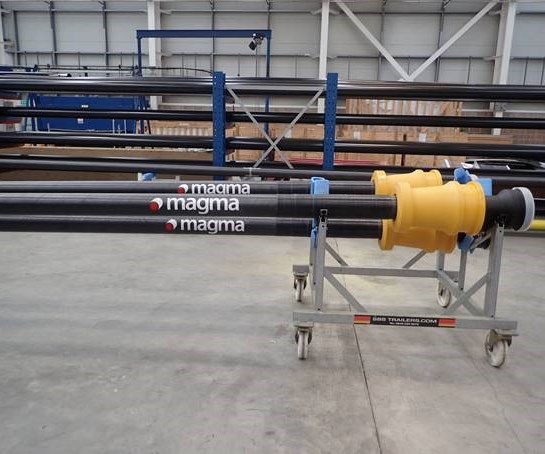CompositesWorld News for Dec. 18, 2019
Read news from Henkel AG & Co. KGaA, Exel Composites Plc, and Toray Industries
Henkel, Fortify partner to enable high-performance applications in 3D printing
The companies are leveraging Fortify’s composite 3D printing technology with Henkel’s resins for injection mold tools and other applications.

A 3D-printed tool by Fortify that is used to mold an automotive part. Source | Henkel
In a new partnership, Henkel (Düsseldorf, Germany) and Fortify (Boston, Mass., U.S.) are leveraging Fortify’s Digital Composite Manufacturing (DCM) 3D printing technology with high-temperature, high-modulus resins developed by Henkel.
In this combined solution, Fortify’s DCM technology mixes reinforcing fibers with Henkel’s resins, and then utilizes magnetics to align the fibers for optimum strength in printed parts. Read more about Fortify’s magnetic 3D printing for tailored composites.
Leveraging Henkel’s material, Fortify will begin field beta testing its 3D printers in the spring of 2020. Beyond injection molding, Henkel and Fortify are looking at several end-use part applications where their combined solutions offer a significant advantage.
According to Henkel, injection molded parts that are reinforced with fibers typically show 20-100% increases in strength, stiffness and heat deflection temperature (HDT), and Fortify brings these same performance advantages to the 3D printing space. 3D-printed injection mold tools are one application where Fortify is focusing in its partnership with Henkel. Replacing traditional metal tooling with inserts that are 3D-printed enables molders to save time and tooling costs.
“Our strong, data-driven approach to material innovation continues to unlock the power of additive manufacturing. Fortify is focused on delivering value in industries where part performance is mission critical. Together, we’re making it happen,” says Ken Kisner, innovation lead for 3D printing at Henkel and founder of Molecule Corp., which was acquired by Henkel earlier this year.
“When prototyping or producing parts in small runs, tooling cost and time are major barriers,” says Karlo Delos Reyes, VP of applications and co-founder at Fortify. “With our 3D-printed molds that utilize Henkel’s resin, we have proved the viability of these tools for low production runs. As we help injection molders reduce the expense and time involved with producing molds, they can quickly react to new opportunities.”
Exel Composites supplies fiberglass profiles for electric buses
Exel Composites provided Chinese bus supplier Yutong with the skirt and side panels for 33 electric buses, which were delivered to Helsinki, Finland.

Source | Exel Composites
Exel Composites (Vantaa, Finland), in a partnership with bus and coach supplier Yutong (Zhengzhou, China), has provided and delivered fiberglass profiles for 33 electric buses in Helsinki, Finland. Exel Composites provided Yutong with the skirt and side panels of the electric buses, which were delivered to Finnish bus and road operator, Pohjolan Liikenne.
According to Exel, composites reduce weight on the buses, reducing fuel consumption and lifetime maintenance costs, and increasing efficiency. The introduction of the electric buses is part of Finland’s goal to reduce carbon dioxide emissions by 5 million kilograms per year.
According to Exel, these electric buses mark the first time that Yutong, which became the first listed bus company in China in 1997, has entered the Finnish market. This is also the largest volume of buses that Finland has purchased from overseas. The country aims to have 400 electric buses operating in the capital by 2025.
“The light weight of fiberglass was important to this project, as it reduces operating costs and helps to increase energy efficiency and environmental sustainability,” says Kathy Wang, head of the North Asia sales region at Exel Composites. “Additionally, our composite profiles are resistant to deformation, chemicals and harsh road environments. Repairing fiberglass is straightforward and can be done in depot. This means that the overall operational maintenance and lifetime costs of the buses is decreased.”
Magma m-pipe chosen for Gulf of Mexico flowline intervention
Magma Global’s carbon fiber/PEEK m-pipe subsea jumpers will be used by C-Innovation for remediation of suspected subsea pipe blockage.

Source | Magma Global
Magma Global (Portsmouth, U.K.) announced on Dec. 17 that it has been selected by C-Innovation (Mandeville, La., U.S.) to supply m-pipe thermoplastic composite subsea jumpers for flowline intervention in the Gulf of Mexico. The 4-inch diameter, 10 ksi m-pipes are expected to be deployed in the next few months.
C-Innovation is planning to perform a remediation of suspected blockage or restriction in a subsea production system using Flexi-Coil. The work will be performed in water depths of up to 6,500 feet on different assets within the Gulf of Mexico. It will involve lowering a drill pipe riser through the moonpool of an offshore support vessel then connecting to subsea infrastructure using the m-pipe jumpers in a free-hanging steep wave configuration. The Flexi-Coil will be run down the drill pipe riser, through the m-pipe jumper and into the production flowline.
m-pipe is a thermoplastic composite pipe (TCP) that is made from polyetheretherketone (PEEK) and carbon fiber lasered together to form a continuous, bonded flexible pipe. The construction produces a jumper that is lightweight, strong and with high bend strain capacity. In addition, it does not corrode in seawater and has superior resistance against a wide range of oilfield chemicals. The flexible m-pipe jumper will remove heave from the vessel and provide a smooth pathway to ease Flexi-Coil access.
“This deployment marks a first for Magma in the Gulf of Mexico. We are seeing a rapid rise in the number of contractors looking to exploit m-pipe as it is increasingly accepted that TCP is the future for the oil and gas industry,” says Charles Tavner, chief operating officer at Magma Global.
Toray opens R&D Innovation Center for the Future
The Shiga, Japan facility will spearhead Toray’s global research as its functional materials headquarters.

Toray’s R&D Innovation Center of the Future. Source | Toray
Toray Industries Inc. (Tokyo, Japan) held an opening ceremony on Dec. 11 for its R&D Innovation Center for the Future on the premises of its Shiga, Japan plant. The new facility will spearhead Toray’s global research as its functional materials headquarters, and is the location where Toray will pursue technology R&D projects in collaboration with its domestic and overseas production and sales units.
During the opening ceremony, Toray President Akihiro Nikkaku said that the center “will play a vital role in helping resolve such global issues as climate change, water shortages and resource depletion. I also look for the facility to serve as a vehicle for joint research and development collaborations with universities and public research institutions around the world.”

The ribbon-cutting ceremony for Toray’s R&D Innovation Center for the Future was held on Dec. 11. Toray President Akihiro Nikkaku is pictured third from the left. Source | Toray
The center comprises two buildings. One will undertake integrated research to generate ideas for the revolutionary materials, ideas and systems, and the other will engage in empirical research through prototyping, assessments and demonstrations.
On the research development side, Toray says it plans to integrate its fine polymers and nanofabrication from its proprietary polymer technology with materials informatics and artificial intelligence. The goal is to advance research and technological development by creating advanced materials, devices and systems in advanced medical, renewable energy, filtration and separation systems, as well as other eco and lifestyle innovation areas.
One ongoing research project includes Toray’s porous carbon fiber with nano-sized continous pore structure, announced last month.
The facility will also serve as an innovation hub through its international conference hall, exhibition and demonstration areas, and open laboratories. Toray says this center will serve as a space to engage and collaborate with with academia and key partners in diverse fields.
U.S. DOE to fund automotive composites among 2020 research
The Department of Energy Vehicle Technologies Office’s 2020 funding opportunity announcement includes composites research for vehicle applications.

On Dec. 12, the U.S. Department of Energy’s Vehicle Technologies Office published a notice of intent to issue a Funding Opportunity Announcement (FOA) titled “Fiscal Year 2020 Advanced Vehicle Technologies Research FOA.” This FOA will support a broad portfolio of advanced vehicle technologies, including composites technologies, with the stated goals of strengthening national security, enabling future economic growth, supporting American energy dominance and increasing transportation affordability for Americans.
According to the notice of intent, this FOA may include the following topics:
- lightweight and high-performance fiber-reinforced polymer composites for vehicle applications,
- lithium-ion batteries using silicon-based anodes,
- low-cost electric traction drive systems using no heavy rare earth materials,
- utility managed smart charging,
- platinum group metals content reduction to enable cost-effective aftertreatment for gasoline and diesel engines,
- improved efficiency of medium- and heavy-duty natural gas and propane (LPG) engines,
- energy-efficient off-road technologies directly applicable to the agriculture sector and/or other off-road vehicles,
- energy-efficient mobility systems,
- technology integration and
- transportation and energy analysis.
The Vehicle Technologies’ portfolio includes advanced batteries, electric drive systems; smart charging technologies; energy-efficient mobility technologies and systems; advanced combustion engines and fuels; materials for vehicle lightweighting; technology integration, which includes work with the national network of Clean Cities coalitions; and transportation and energy analysis.
Related Content
Plant tour: Dowty Propellers, Gloucester, U.K.
Transforming decades of design and RTM production reliability into more sustainable, next-generation composite propellers.
Read MoreMaterials & Processes: Composites fibers and resins
Compared to legacy materials like steel, aluminum, iron and titanium, composites are still coming of age, and only just now are being better understood by design and manufacturing engineers. However, composites’ physical properties — combined with unbeatable light weight — make them undeniably attractive.
Read MoreRecycling end-of-life composite parts: New methods, markets
From infrastructure solutions to consumer products, Polish recycler Anmet and Netherlands-based researchers are developing new methods for repurposing wind turbine blades and other composite parts.
Read MoreCarbon fiber in pressure vessels for hydrogen
The emerging H2 economy drives tank development for aircraft, ships and gas transport.
Read MoreRead Next
From the CW Archives: The tale of the thermoplastic cryotank
In 2006, guest columnist Bob Hartunian related the story of his efforts two decades prior, while at McDonnell Douglas, to develop a thermoplastic composite crytank for hydrogen storage. He learned a lot of lessons.
Read MoreCW’s 2024 Top Shops survey offers new approach to benchmarking
Respondents that complete the survey by April 30, 2024, have the chance to be recognized as an honoree.
Read MoreComposites end markets: Energy (2024)
Composites are used widely in oil/gas, wind and other renewable energy applications. Despite market challenges, growth potential and innovation for composites continue.
Read More




















.jpg;maxWidth=300;quality=90)








